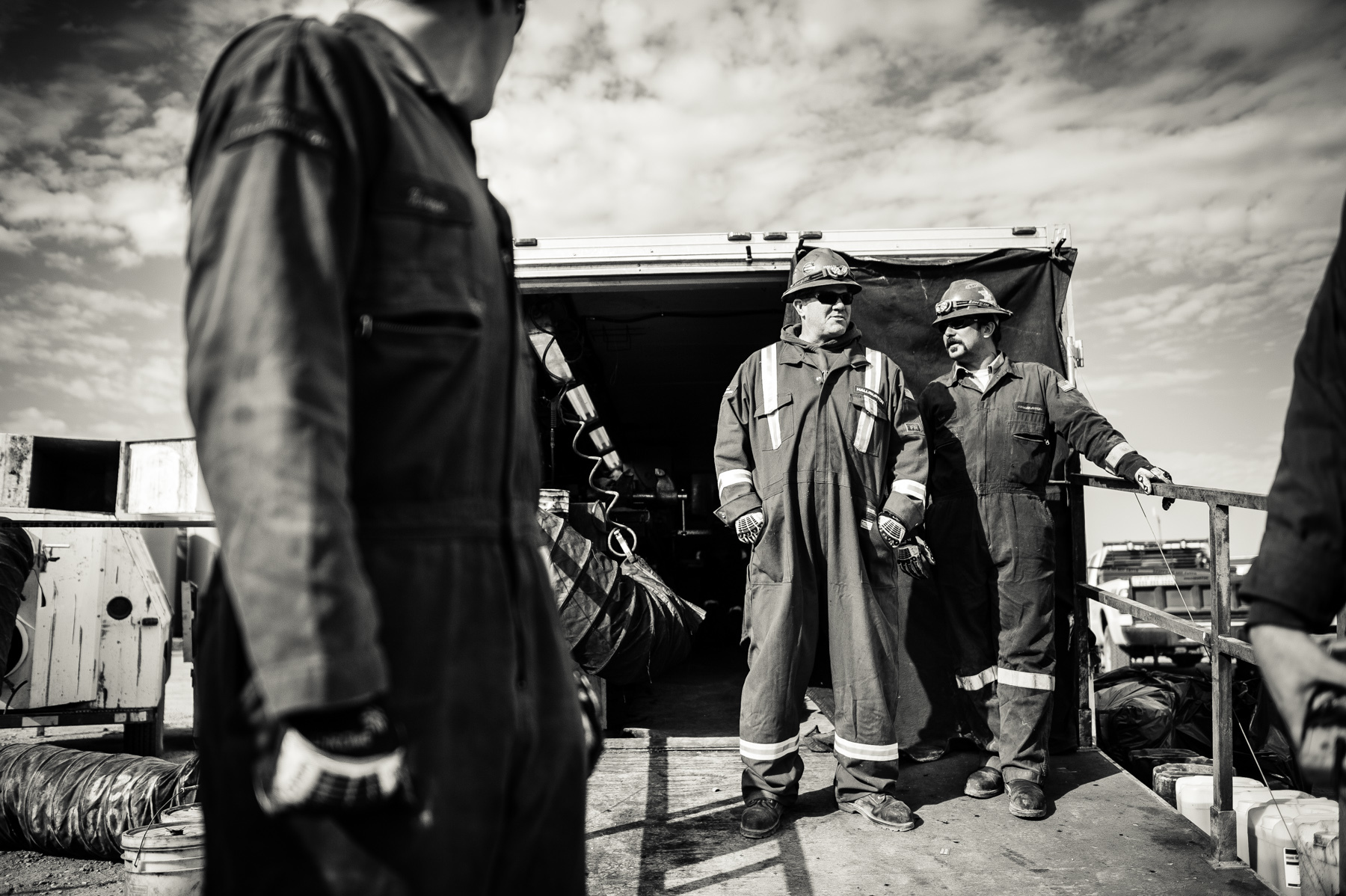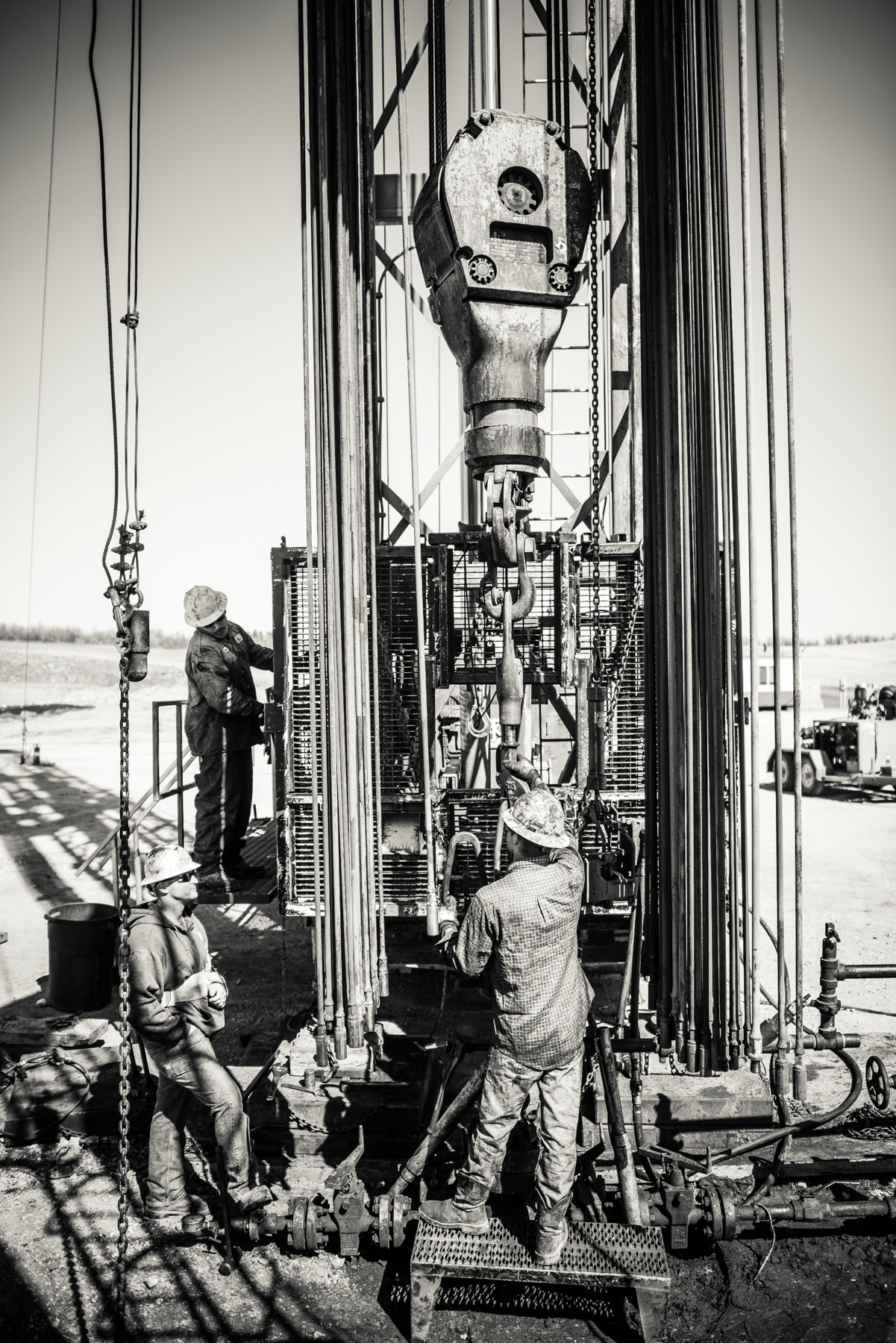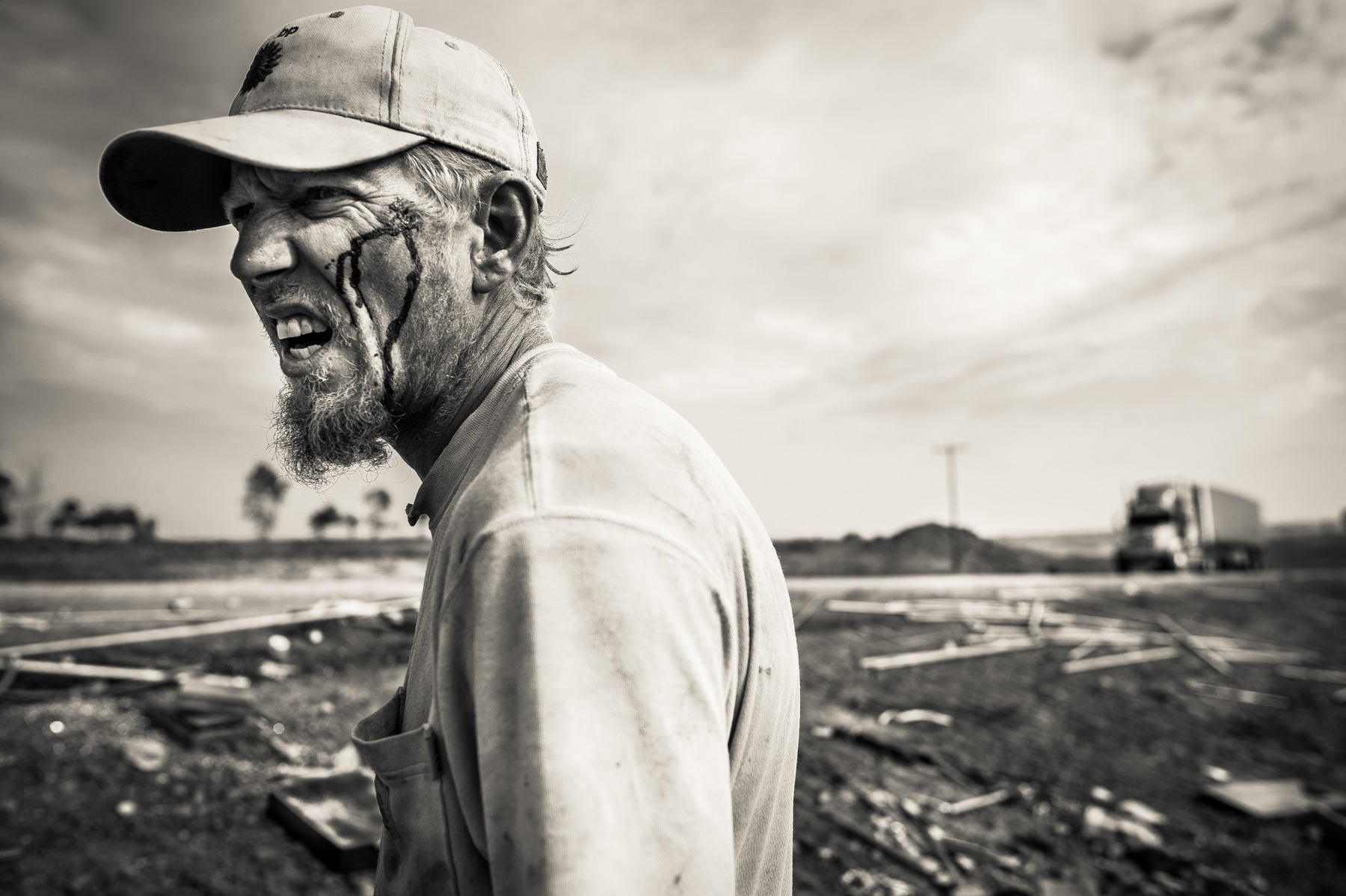
A Hess oil pump jack overlooks the North Dakota oil fields known as the Bakken in the aftermath of a thunderstorm.

As workers remove the last of four miles of drill pipe, hot salt water released from deep in the earth blasts out of the oil well and douses the crew of three men confined to a basket 40 feet above the ground. The entire crew is especially vigilant during this, the most dangerous part of the fracking process. A false move could send the highly pressured drill pipe shooting hundreds of feet into the air, destroying equipment and killing men as it returns to the ground.

An oil well head during the process of Hydraulic Fracturing, aka fracking. The many pipes leading into the well contain water, sand and some chemical lubricants forced in by the massive pump trucks in the background.

A worker at a frack site, aka a "fracker," installing part of the massive plumbing project that will lead to the fracking of this oil well.

Men from a workover crew lifting a swivel head into place to complete the fracking of an oil well. Crews work in alternating 12 hour shifts throughout the entire drilling and fracking process. The work never stops on a drill site.

A wireline crew waiting for operations to commence. The wireline operators are responsible for inserting and setting off the shaped explosive charges that penetrate the drill pipe and surrounding rock thus allowing the high pressure water to radiate into the surrounding rock and release the oil.

A workover crew removing four miles of pump rod to repair a well. The work is unending, incredibly physical and dangerous, as witnessed by the cast on the broken arm of the attending supervisor.

Pump jack and storage tanks at a pump site. Tanks always come in groups of threes: two for water, one for oil.

Prior to the current boom of oil production in western North Dakota, dry wheat farming was the primary source of income for area residents. Farmers will tell stories of growing up without money for shoes, but now find themselves millionaires. The dominant narrative amongst long time residents is of economic advancement, not environmental woe.

The first oil boom in Williston, North Dakota took place in the 50's. Much of the architecture of the small downtown reflects the population and economic growth that took place in this era. The boom soon fizzled however leaving the downtown to slowly slide into disuse.

This worker and his girlfriend migrated from Montana to find work in bustling Williston. Together with her two children, they live in a small travel trailer in a muddy trailer park outside of town.

This supervisor to a fracking crew is set to build his home on this plot of land outside of Williston. Until recently, his wife and two children lived in faraway North Carolina while he labored in the oil fields - earning $300,000 per year for his efforts. Now feeling secure in his future, he opted to reunite his family. His young daughter, a new, reluctant arrival to the area, sits on his shoulders.

A woman, wife to an oil industry worker, stands in her travel trailer home while her husband and his friend talk and drink beer in the adjacent makeshift den.

This all Hispanic workover crew enjoys their brief time off by drinking beer on the edge of their man camp. To discourage the otherwise bored men from drinking, their shifts begin at midnight and end at noon. The bars are not open when their shifts end so the thinking is that the men are less likely to drink. The men persist regardless.

An electrician after crashing his truck along the highway outside of Tioga, North Dakota. In reaching for his dropped wallet, he lost control of his truck and veered of the highway, rolling the vehicle in the process. Crashes along the lonely, often snow covered highways are not uncommon and rank among the most dangerous aspects of working in the area.

Worker in a service yard that provides equipment to local drill companies.

Roustabout at an oil company storage site.

Workover crewman after a 12 hour shift.


















A Hess oil pump jack overlooks the North Dakota oil fields known as the Bakken in the aftermath of a thunderstorm.
As workers remove the last of four miles of drill pipe, hot salt water released from deep in the earth blasts out of the oil well and douses the crew of three men confined to a basket 40 feet above the ground. The entire crew is especially vigilant during this, the most dangerous part of the fracking process. A false move could send the highly pressured drill pipe shooting hundreds of feet into the air, destroying equipment and killing men as it returns to the ground.
An oil well head during the process of Hydraulic Fracturing, aka fracking. The many pipes leading into the well contain water, sand and some chemical lubricants forced in by the massive pump trucks in the background.
A worker at a frack site, aka a "fracker," installing part of the massive plumbing project that will lead to the fracking of this oil well.
Men from a workover crew lifting a swivel head into place to complete the fracking of an oil well. Crews work in alternating 12 hour shifts throughout the entire drilling and fracking process. The work never stops on a drill site.
A wireline crew waiting for operations to commence. The wireline operators are responsible for inserting and setting off the shaped explosive charges that penetrate the drill pipe and surrounding rock thus allowing the high pressure water to radiate into the surrounding rock and release the oil.
A workover crew removing four miles of pump rod to repair a well. The work is unending, incredibly physical and dangerous, as witnessed by the cast on the broken arm of the attending supervisor.
Pump jack and storage tanks at a pump site. Tanks always come in groups of threes: two for water, one for oil.
Prior to the current boom of oil production in western North Dakota, dry wheat farming was the primary source of income for area residents. Farmers will tell stories of growing up without money for shoes, but now find themselves millionaires. The dominant narrative amongst long time residents is of economic advancement, not environmental woe.
The first oil boom in Williston, North Dakota took place in the 50's. Much of the architecture of the small downtown reflects the population and economic growth that took place in this era. The boom soon fizzled however leaving the downtown to slowly slide into disuse.
This worker and his girlfriend migrated from Montana to find work in bustling Williston. Together with her two children, they live in a small travel trailer in a muddy trailer park outside of town.
This supervisor to a fracking crew is set to build his home on this plot of land outside of Williston. Until recently, his wife and two children lived in faraway North Carolina while he labored in the oil fields - earning $300,000 per year for his efforts. Now feeling secure in his future, he opted to reunite his family. His young daughter, a new, reluctant arrival to the area, sits on his shoulders.
A woman, wife to an oil industry worker, stands in her travel trailer home while her husband and his friend talk and drink beer in the adjacent makeshift den.
This all Hispanic workover crew enjoys their brief time off by drinking beer on the edge of their man camp. To discourage the otherwise bored men from drinking, their shifts begin at midnight and end at noon. The bars are not open when their shifts end so the thinking is that the men are less likely to drink. The men persist regardless.
An electrician after crashing his truck along the highway outside of Tioga, North Dakota. In reaching for his dropped wallet, he lost control of his truck and veered of the highway, rolling the vehicle in the process. Crashes along the lonely, often snow covered highways are not uncommon and rank among the most dangerous aspects of working in the area.
Worker in a service yard that provides equipment to local drill companies.
Roustabout at an oil company storage site.
Workover crewman after a 12 hour shift.